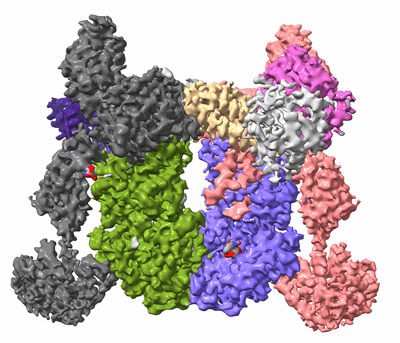EMD-42300
Structure of the C3bBb-albicin complex
EMD-42300
Single-particle3.86 Å
 Deposition: 10/10/2023
Deposition: 10/10/2023Map released: 08/05/2024
Last modified: 20/11/2024
Sample Organism:
Homo sapiens,
Anopheles albimanus
Sample: complex of C3bBb with the inhibitor albicin
Fitted models: 8uin (Avg. Q-score: 0.379)
Deposition Authors: Andersen JF ,
Lei H
,
Lei H 
Sample: complex of C3bBb with the inhibitor albicin
Fitted models: 8uin (Avg. Q-score: 0.379)
Deposition Authors: Andersen JF
 ,
Lei H
,
Lei H 
Mechanism of complement inhibition by a mosquito protein revealed through cryo-EM.
Abstract:
Salivary complement inhibitors occur in many of the blood feeding arthropod species responsible for transmission of pathogens. During feeding, these inhibitors prevent the production of proinflammatory anaphylatoxins, which may interfere with feeding, and limit formation of the membrane attack complex which could damage arthropod gut tissues. Salivary inhibitors are, in many cases, novel proteins which may be pharmaceutically useful or display unusual mechanisms that could be exploited pharmaceutically. Albicin is a potent inhibitor of the alternative pathway of complement from the saliva of the malaria transmitting mosquito, Anopheles albimanus. Here we describe the cryo-EM structure of albicin bound to C3bBb, the alternative C3 convertase, a proteolytic complex that is responsible for cleavage of C3 and amplification of the complement response. Albicin is shown to induce dimerization of C3bBb, in a manner similar to the bacterial inhibitor SCIN, to form an inactive complex unable to bind the substrate C3. Size exclusion chromatography and structures determined after 30 minutes of incubation of C3b, factor B (FB), factor D (FD) and albicin indicate that FBb dissociates from the inhibited dimeric complex leaving a C3b-albicin dimeric complex which apparently decays more slowly.
Salivary complement inhibitors occur in many of the blood feeding arthropod species responsible for transmission of pathogens. During feeding, these inhibitors prevent the production of proinflammatory anaphylatoxins, which may interfere with feeding, and limit formation of the membrane attack complex which could damage arthropod gut tissues. Salivary inhibitors are, in many cases, novel proteins which may be pharmaceutically useful or display unusual mechanisms that could be exploited pharmaceutically. Albicin is a potent inhibitor of the alternative pathway of complement from the saliva of the malaria transmitting mosquito, Anopheles albimanus. Here we describe the cryo-EM structure of albicin bound to C3bBb, the alternative C3 convertase, a proteolytic complex that is responsible for cleavage of C3 and amplification of the complement response. Albicin is shown to induce dimerization of C3bBb, in a manner similar to the bacterial inhibitor SCIN, to form an inactive complex unable to bind the substrate C3. Size exclusion chromatography and structures determined after 30 minutes of incubation of C3b, factor B (FB), factor D (FD) and albicin indicate that FBb dissociates from the inhibited dimeric complex leaving a C3b-albicin dimeric complex which apparently decays more slowly.
